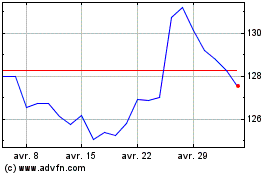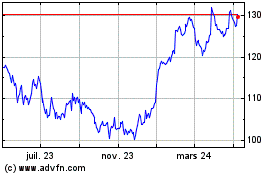Approval Based on Results of Phase 3 Trial
Evaluating Critically Ill Patients with Pneumonia; 100% of Patients
Were on Mechanical Ventilation
Merck (NYSE:MRK), known as MSD outside the United States and
Canada, today announced that the U.S. Food and Drug Administration
(FDA) has approved Merck’s supplemental New Drug Application (sNDA)
for the use of ZERBAXA® (ceftolozane and tazobactam) for the
treatment of patients 18 years and older with hospital-acquired
bacterial pneumonia and ventilator-associated bacterial pneumonia
(HABP/VABP) caused by the following susceptible Gram-negative
microorganisms: Enterobacter cloacae, Escherichia coli, Haemophilus
influenzae, Klebsiella oxytoca, Klebsiella pneumoniae, Proteus
mirabilis, Pseudomonas aeruginosa, and Serratia marcescens. The
sNDA for ZERBAXA had previously been designated Priority Review
status by the FDA. To reduce the development of drug-resistant
bacteria and maintain the effectiveness of ZERBAXA and other
antibacterial drugs, ZERBAXA should be used only to treat or
prevent infections that are proven or strongly suspected to be
caused by susceptible bacteria.
This expanded use is based on results of the pivotal Phase 3
ASPECT-NP trial that compared ZERBAXA 3g (ceftolozane 2g and
tazobactam 1g) intravenously every 8 hours to meropenem (1g
intravenously every 8 hours) for 8 to 14 days for the treatment of
adult patients with HABP/VABP.
ZERBAXA is contraindicated in patients with known serious
hypersensitivity to the components of ZERBAXA
(ceftolozane/tazobactam), piperacillin/tazobactam, or other members
of the beta-lactam class. Serious and occasionally fatal
hypersensitivity (anaphylactic) reactions have been reported in
patients receiving beta-lactam antibacterials. Additionally,
Clostridium difficile-associated diarrhea (CDAD), ranging from
mild diarrhea to fatal colitis, has been reported with nearly all
systemic antibacterial agents, including ZERBAXA. See Important
Safety Information below.
“Pneumonia in ventilated patients remains a significant clinical
challenge and is associated with substantial morbidity and
mortality,” said Dr. Andrew Shorr, head of pulmonary, critical care
and respiratory services, Medstar Washington Hospital Center,
Washington, D.C. “The need to cover diverse pathogens including
Pseudomonas aeruginosa and certain Enterobacteriaceae adds to the
challenge.”
According to a recent publication by the Foundation for the
National Institutes of Health Biomarkers Consortium, ventilated
patients with HABP have a higher rate of mortality (39%) than those
with VABP (27%). In addition, Pseudomonas aeruginosa is the most
common Gram-negative pathogen in HABP/VABP and is becoming
increasingly difficult to treat.
“We are grateful to all of the patients who participated in the
studies which led to the approval of ZERBAXA for the treatment of
HABP/VABP,” said Dr. Roy Baynes, senior vice president and head of
global clinical development, chief medical officer, Merck Research
Laboratories. “This approval reflects Merck’s longstanding
commitment to helping alleviate the burden of infectious diseases,
including serious infections caused by Gram-negative
pathogens.”
Clinical Data Supporting Use of ZERBAXA (Ceftolozane and
Tazobactam) in HABP/VABP
A total of 726 adult patients hospitalized with HABP/VABP were
enrolled in a multinational, double-blind study (NCT 02070757)
comparing ZERBAXA 3g (ceftolozane 2g and tazobactam 1g)
intravenously every 8 hours to meropenem (1g intravenously
every 8 hours) for 8 to 14 days of therapy. All patients
had to be intubated and on mechanical ventilation at
randomization.
Efficacy was assessed based on all-cause mortality at Day 28 and
clinical cure, defined as complete resolution or significant
improvement in signs and symptoms of the index infection at the
test-of-cure (TOC) visit which occurred 7 to 14 days after the end
of treatment. The analysis population was the intent-to-treat (ITT)
population, which included all randomized patients.
Of the 726 patients in the ITT population, the median age was
62 years and 44% of the population was greater than or equal
to 65 years of age, with 22% of the population greater than or
equal to 75 years of age. The majority of patients were white
(83%), male (71%) and were from Eastern Europe (64%). The median
APACHE II score was 17 and 33% of patients had a baseline APACHE II
score of greater than or equal to 20. All patients were on
mechanical ventilation and 519 (71%) had VABP. At randomization,
the majority of patients had been hospitalized for greater than or
equal to 5 days (77%) and were in an ICU (92%), with 49% of
patients ventilated for greater than or equal to 5 days. At
baseline, 36% of patients had creatinine clearance (CrCl) less than
80 mL/min. Of these, 14% had CrCl less than 50 mL/min.
Approximately 13% of patients were failing their current
antibacterial drug therapy for HABP/VABP, and bacteremia was
present at baseline in 15% of patients. Key comorbidities included
diabetes mellitus, congestive heart failure, and chronic
obstructive pulmonary disease at rates of 22%, 16% and 12%,
respectively.
ZERBAXA (ceftolozane and tazobactam) was non-inferior to
meropenem for 28-day all-cause mortality in the ITT population (all
randomized patients), 24.0% (87/362) and 25.3% (92/364)
respectively, for a weighted proportion difference of 1.1
(stratified 95% CI: -5.13, 7.39; non-inferiority margin of 10%). In
addition, ZERBAXA was non-inferior to meropenem for clinical
response at Test-of-Cure (7-14 days after the end of therapy) in
the ITT population, 54.4% (197/362) and 53.3% (194/364)
respectively, for a weighted proportion difference of 1.1
(stratified 95% CI: -6.17, 8.29; non-inferiority margin of
12.5%).
In the ventilated HABP sub-group, a favorable response for
ZERBAXA in 28-day all-cause mortality was observed, 24.2% (24/99)
for ZERBAXA and 37.0% (40/108) for meropenem, respectively, for a
weighted proportion difference of 12.8 (stratified 95% CI: 0.18,
24.75). In the VABP subgroup, 28-day all-cause mortality was 24.0%
(63/263) for ZERBAXA and 20.3% (52/256) for meropenem, for a
weighted proportion difference of -3.6 (stratified 95% CI: -10.74,
3.52).
Adverse reactions occurring in 2% or greater of patients
receiving ZERBAXA in this study include hepatic transaminase
increased 11.9% (43/361), renal impairment/renal failure 8.9%
(32/361), diarrhea 6.4% (23/361), intracranial hemorrhage 4.4%
(16/361), vomiting 3.3% (12/361), and Clostridium difficile colitis
2.8% (10/361). Treatment discontinuation due to adverse reactions
occurred in 1.1% (4/361) of patients receiving ZERBAXA and 1.4%
(5/359) of patients receiving meropenem.
Additional Important Safety Information about ZERBAXA
(ceftolozane and tazobactam)
Patients with changing renal function: Dose adjustment is
required for patients with CrCl 50 mL/min or less. All doses of
ZERBAXA are administered over 1 hour. Monitor CrCl at least daily
in patients with changing renal function and adjust the dose of
ZERBAXA accordingly.
Hypersensitivity: ZERBAXA is contraindicated in patients
with known serious hypersensitivity to the components of ZERBAXA
(ceftolozane/tazobactam), piperacillin/tazobactam, or other members
of the beta-lactam class. Serious and occasionally fatal
hypersensitivity (anaphylactic) reactions have been reported in
patients receiving beta-lactam antibacterials. Before initiating
therapy with ZERBAXA, make careful inquiry about previous
hypersensitivity reactions to cephalosporins, penicillins, or other
beta-lactams. If an anaphylactic reaction to ZERBAXA occurs,
discontinue use and institute appropriate therapy.
Clostridium difficile-associated diarrhea (CDAD),
ranging from mild diarrhea to fatal colitis, has been reported with
nearly all systemic antibacterial agents, including ZERBAXA.
Careful medical history is necessary because CDAD has been reported
to occur more than 2 months after the administration of
antibacterial agents. If CDAD is confirmed, antibacterial use not
directed against C. difficile should be discontinued, if
possible.
Development of drug-resistant bacteria: Prescribing
ZERBAXA in the absence of a proven or strongly suspected bacterial
infection or a prophylactic indication is unlikely to provide
benefit to the patient and risks the development of drug-resistant
bacteria.
Adverse Reactions: The most common adverse reactions
occurring in ≥5% of patients. in the HABP/VABP trial were increase
in hepatic transaminases (11.9%), renal impairment/renal failure
(8.9%) and diarrhea (6.4%).
About ZERBAXA (ceftolozane and tazobactam)
ZERBAXA is an antibacterial combination product for intravenous
infusion consisting of the cephalosporin antibacterial drug
ceftolozane sulfate and the beta-lactamase inhibitor tazobactam
sodium.
ZERBAXA 3g dose (ceftolozane 2g and tazobactam 1g) is approved
in the United States and is indicated for treatment of patients 18
years and older with hospital-acquired bacterial pneumonia and
ventilator-associated bacterial pneumonia (HABP/VABP) caused by the
following susceptible Gram-negative microorganisms: Enterobacter
cloacae, Escherichia coli, Haemophilus influenzae, Klebsiella
oxytoca, Klebsiella pneumoniae, Proteus mirabilis, Pseudomonas
aeruginosa, and Serratia marcescens.
To reduce the development of drug-resistant bacteria and
maintain the effectiveness of ZERBAXA and other antibacterial
drugs, ZERBAXA should be used only to treat or prevent infections
that are proven or strongly suspected to be caused by susceptible
bacteria. When culture and susceptibility information are
available, they should be considered in selecting or modifying
antibacterial therapy. In the absence of such data, local
epidemiology and susceptibility patterns may contribute to the
empiric selection of therapy.
About Merck
For more than a century, Merck, a leading global
biopharmaceutical company known as MSD outside of the United States
and Canada, has been inventing for life, bringing forward medicines
and vaccines for many of the world’s most challenging diseases.
Through our prescription medicines, vaccines, biologic therapies
and animal health products, we work with customers and operate in
more than 140 countries to deliver innovative health solutions. We
also demonstrate our commitment to increasing access to health care
through far-reaching policies, programs and partnerships. Today,
Merck continues to be at the forefront of research to advance the
prevention and treatment of diseases that threaten people and
communities around the world - including cancer, cardio-metabolic
diseases, emerging animal diseases, Alzheimer’s disease and
infectious diseases including HIV and Ebola. For more information,
visit www.merck.com and connect with us on
Twitter, Facebook, Instagram, YouTube and
LinkedIn.
Forward-Looking Statement of Merck & Co., Inc.,
Kenilworth, N.J., USA
This news release of Merck & Co., Inc., Kenilworth, N.J.,
USA (the “company”) includes “forward-looking statements” within
the meaning of the safe harbor provisions of the U.S. Private
Securities Litigation Reform Act of 1995. These statements are
based upon the current beliefs and expectations of the company’s
management and are subject to significant risks and uncertainties.
There can be no guarantees with respect to pipeline products that
the products will receive the necessary regulatory approvals or
that they will prove to be commercially successful. If
underlying assumptions prove inaccurate or risks or uncertainties
materialize, actual results may differ materially from those set
forth in the forward-looking statements.
Risks and uncertainties include but are not limited to, general
industry conditions and competition; general economic factors,
including interest rate and currency exchange rate fluctuations;
the impact of pharmaceutical industry regulation and health care
legislation in the United States and internationally; global trends
toward health care cost containment; technological advances, new
products and patents attained by competitors; challenges inherent
in new product development, including obtaining regulatory
approval; the company’s ability to accurately predict future market
conditions; manufacturing difficulties or delays; financial
instability of international economies and sovereign risk;
dependence on the effectiveness of the company’s patents and other
protections for innovative products; and the exposure to
litigation, including patent litigation, and/or regulatory
actions.
The company undertakes no obligation to publicly update any
forward-looking statement, whether as a result of new information,
future events or otherwise. Additional factors that could cause
results to differ materially from those described in the
forward-looking statements can be found in the company’s 2018
Annual Report on Form 10-K and the company’s other filings with the
Securities and Exchange Commission (SEC) available at the SEC’s
Internet site (www.sec.gov).
Please see Prescribing Information for ZERBAXA (ceftolozane
and tazobactam)
at http://www.merck.com/product/usa/pi_circulars/z/zerbaxa/zerbaxa_pi.pdf
View source
version on businesswire.com: https://www.businesswire.com/news/home/20190603005822/en/
Media:Pam Eisele(267) 305-3558Sarra Herzog(908)
740-1871Investors:Teri Loxam(908) 740-1986Michael DeCarbo(908)
740-1807
Merck (NYSE:MRK)
Graphique Historique de l'Action
De Mar 2024 à Avr 2024

Merck (NYSE:MRK)
Graphique Historique de l'Action
De Avr 2023 à Avr 2024
